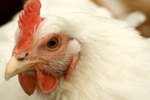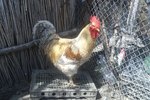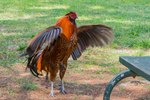Things You'll Need
New bedding
Malathion spray
Malathion dust, or sulfur dust, or crankcase oil
Rotary hand duster or puff duster
Paint brush (for treating scaly leg mites)
Chickens are at risk of infestation by parasites like fleas and mites. While these parasites are small and might not look very dangerous, a severe infestation can seriously harm and even kill a chicken. Signs of flea or mite infestation can include loss of feathers, scaly or scabby skin, and ragged or discolored feathers. Chickens can also become listless, lethargic and pale around their heads, and might stop laying eggs. In order to protect your chickens’ health, you need to recognize the signs of flea and mite infestation and use the proper treatment to rid your birds of these harmful parasites.
Examine your chickens. Northern fowl or feather mites live at the base of the feathers, especially around the tail, and you might find mites on the chickens’ eggs. Depluming mites live at the base of the feathers and cause the birds to itch and pull out their feathers. The pulled feathers will often have scaly skin on their quills. Scaly leg mites cause swelling and scaliness on the legs and/or wattles. Fleas live at the base of the feathers and, unlike mites, can hop.
Determine if only one bird is infested, or if the entire flock is. If it is only one bird, separate it from the rest of the flock.
Dust chickens infested with fleas, northern fowl (feather) mites or chicken mites with 4 percent or 5 percent malathion dust, using a rotary hand duster or puff duster. Use one pound of dust per 100 birds. Repeat treatment in four to eight weeks or as needed.
Dust chickens infested with depluming mites with sulfur dust, making sure to thoroughly cover the neck, abdomen and underwing feathers.
Cover the feet and lower legs of chickens infested with scaly leg mites with crude oil or crankcase oil. You can use a paint brush to apply the oil. Do not get the oil on the bird’s flesh or feathers. Reapply after three weeks if the distorted scales haven’t been shed. You may also use Ivermectin, especially for severe cases.
Spray walls, nests, roosts, ceilings and adjacent areas with malathion spray. Add 4 tbsp. of 57 percent emulsifiable liquid or 5 ounces of 25 percent wettable powder per gallon of water for chicken mites, northern fowl (feather) mites or fleas. For chicken mites, force the spray into all cracks and crevices.
Replace the bedding.
See the veterinarian for treatment of any complications, such as skin infections.
Monitor the birds for reinfestation.
Tips
While some mites live on the chickens, chicken mites live in cracks and crevices during the day and come out at night to feed on the chickens’ blood, like bedbugs in humans. Remember that your chickens might have a chicken mite problem even if you don’t see any mites on the birds.
If you aren’t sure what type of parasite your birds have, or if they do not respond to treatment, see your veterinarian.
Warnings
Make sure to use pesticides exactly as the label says and only on the animals listed on the label. Be very careful not to get pesticides on your skin or in your eyes, and apply pesticides in a well-ventilated area. Make sure you don’t contaminate the feed or feed trough with pesticides, which can poison chickens.
References
Writer Bio
Melissa Sandoval began writing professionally in 1996, dabbling in fiction and writing for new media and magazines. She has published work in "mental_floss magazine" and on websites such as TLC Family and TLC Style. Sandoval has work published in English and Spanish, including online topics guides en Español. Sandoval has a Bachelor of Arts in psychology from Wittenberg University.





